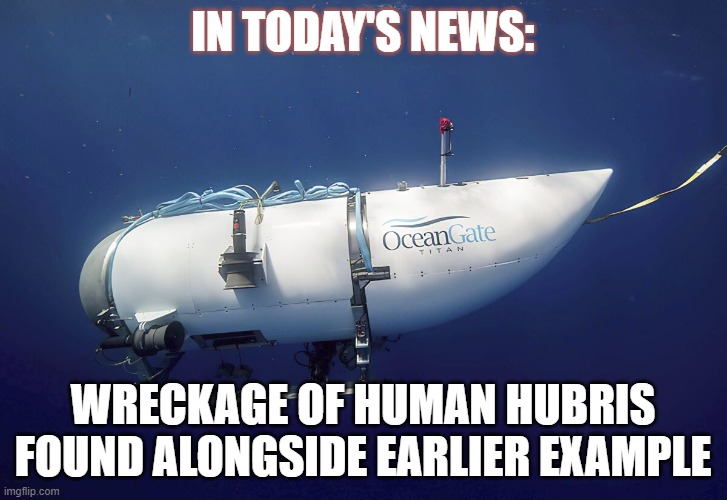
In a dramatic turn of events, the highly anticipated expedition to the wreckage of the Titanic took an unexpected and devastating twist. OceanGate, a renowned submersible manufacturer led by CEO and founder Stockton Rush, along with British businessman Hamish Hardin, British-Pakistan businessman Shahzada Dawood and son, Suleman Dawood, and French explore Paul-Henri Nargeolet, embarked on a historic journey to explore the depths and pay homage to the iconic ship. Little did they know that this ambitious adventure would be marred by a heart-wrenching disaster that left the world in shock and forced the industry to reevaluate the risks and practices associated with deep-sea exploration.

Recalling the Events
On June 18, 2023, aboard the Titan submersible, a group of renowned individuals joined the expedition. Their shared passion for exploration and the allure of unraveling the mysteries of the deep ocean drew them together. Suleman Dawood, though hesitant, agreed to the voyage. The vessel embarked on its voyage, tethered to the Polar Prince ship, eagerly heading towards the Titanic wreckage located off the coast of Newfoundland. However, approximately 1 hour and 45 minutes into the expedition, a sudden and mysterious loss of communication between the Polar Prince and the Titan sent shockwaves through the team and triggered a frantic search and rescue operation across international waters: the Titan sub had suffered a catastrophic implosion, taking the lives of all 5 men aboard the vessel.
The Hubris of Stockton Rush
Amidst the tragedy that unfolded, questions have been raised about the role of CEO Stockton Rush and the decisions made leading up to the ill-fated expedition.

Hanlon’s Razor, a popular adage that states,
“Never attribute to malice that which is adequately explained by stupidity,”
seems to shed light on the situation. Many experts argue that it was not malicious intent but rather a display of hubris on the part of Stockton Rush that contributed to the catastrophe. The rush to achieve new milestones in deep-sea exploration while cutting as many corners without fully considering the potential risks and meticulous engineering practices might have been a crucial misstep.
Engineering Practices: A Missed Opportunity
As investigations into the tragic incident unfolded, experts and armchair observers alike pointed out missed opportunities for ensuring the utmost safety and reliability of the submersible. Meticulous adherence to engineering practices and protocols could have potentially prevented this disaster. Robust stress analysis, comprehensive material testing, and redundant systems are essential pillars of deep-sea exploration. It appears that these crucial engineering practices were either overlooked or underestimated, leading to catastrophic consequences.
Material Science: The Achilles’ Heel of Carbon Fiber
Let’s take a deep dive into the world of carbon fiber, shall we?

Known for its impressive strength-to-weight ratio, carbon fiber has become a darling of the engineering world. This lightweight material, composed of tightly woven carbon filaments, has found applications in various industries, from aerospace to sports equipment. Its exceptional strength, stiffness, and resistance to corrosion have made it a go-to choice for many high-performance applications.
However, as we descend into the depths of the ocean, the story takes a turn. Deep-sea exploration requires submersibles capable of withstanding extreme pressures. Carbon fiber, despite its impressive qualities, struggles under the relentless squeeze of the deep sea. The pressure experienced at depths like the 4,000 meters reached by the ill-fated Titan submersible can exceed 600 atmospheres, equivalent to a weighty sumo wrestler standing on every square inch. This is where the Achilles’ heel of carbon fiber comes into play.
While carbon fiber’s strength and stiffness are admirable in normal conditions, they can falter under immense pressure. Deep-sea explorers must choose materials that can withstand the weight of the world pressing down upon them. Titanium, for instance, with its excellent strength and corrosion resistance, has proven to be a reliable choice for submersibles operating in extreme environments. It has the resilience needed to resist the powerful embrace of the deep sea.
Designing a submersible that can withstand the extreme pressures of the ocean is a delicate dance of materials and engineering. The Titan submersible, with its carbon fiber pressure vessel, posed a risk from the start. Carbon fiber, while suitable for many applications, lacks the brute strength necessary to fend off the crushing forces of the deep sea. It was an accident waiting to happen, a fragile shell venturing into a world of unyielding pressure.
Furthermore, the unique circumstances of this mission may have exacerbated the potential for catastrophe. Previous submersible expeditions, operating at shallower depths or with different design factors, may not have encountered the same degree of danger. The combination of the specific pressure conditions, the duration of the mission, and the structural weaknesses inherent in carbon fiber may have created a perfect storm for implosion. It serves as a haunting reminder that each deep-sea mission brings its own set of challenges and risks that must be carefully considered.
In hindsight, the use of carbon fiber for the pressure vessel of the Titan submersible was a fatal flaw. A wiser choice would have been to opt for materials like titanium or other advanced composites specifically engineered for deep-sea exploration. These materials offer the necessary strength and resilience to withstand the immense pressures encountered in the depths, reducing the risk of catastrophic failures.
As we reflect on this tragic event, it becomes apparent that the choice of materials and meticulous engineering practices are of paramount importance in deep-sea exploration. While carbon fiber has its merits in many applications, the deep sea remains an unforgiving environment that demands robust materials capable of taming its ferocious grip.
The Future of OceanGate: A Company in Turmoil
OceanGate, once a pioneering force in submersible technologies, now finds itself at a crossroads. The repercussions of this tragic event are profound. The company’s reputation is tarnished, and lawsuits loom on the horizon. The families of the victims, as well as stakeholders, demand answers and accountability. The aftermath of this disaster will undoubtedly involve extensive investigations, potential legal battles, and a thorough reevaluation of OceanGate’s practices and responsibilities. The future of the company hangs in the balance, with its survival hinging on its ability to navigate the stormy waters ahead.
Impact on Deep-Sea Exploration: A Moment of Reflection
The Titan submersible tragedy serves as a wake-up call for the entire deep-sea exploration community. It raises critical questions about the inherent risks of venturing into the unknown depths and the imperative of safety precautions. As news of the disaster spread, the public and industry alike engaged in somber reflection. The need for stringent safety regulations, comprehensive risk assessments, and heightened engineering standards has become more evident than ever. Only by approaching future expeditions with utmost care, respect for the environment, and unwavering commitment to safety can the industry regain public trust and move forward.
Conclusion
The Titan submersible tragedy will forever be etched in the annals of deep-sea exploration as a somber reminder of the perils faced by those who dare to venture into the abyss. Amidst the grief and reflection, we must pause to pay tribute to the fallen explorers who embarked on this ill-fated journey. Their unwavering passion, courage, and dedication to uncovering the secrets of the deep ocean embody the true spirit of exploration.

Photo by Oliver Hotakainen on Unsplash
In their pursuit to touch history and honor the Titanic’s legacy, these brave individuals demonstrated a profound commitment to expanding human knowledge. Their sacrifice, though heartbreaking, serves as a poignant reminder that the desire to explore beyond what we know should never be extinguished. It is through their unwavering spirit that we are reminded of the importance of pushing boundaries, embracing curiosity, and embracing the unknown.
As we mourn the loss of these intrepid adventurers, let us find solace in their indomitable spirit and the mark they have left on the world of exploration. Their legacy will forever inspire future generations to reach for the stars, dive into the depths, and venture into uncharted territories. May their memory be a guiding light, reminding us to cherish the thirst for discovery that beats within our own hearts.
In the face of tragedy, we must remain resolute in our commitment to furthering our understanding of the world around us. Let us learn from the lessons of this heartbreaking event, championing enhanced safety measures, meticulous engineering practices, and a deep reverence for the unpredictable forces of nature. From the depths of this tragedy, let us emerge with a renewed determination to honor the fallen explorers by forging ahead, leaving no stone unturned, and continuing their quest to uncover the wonders that lie beneath the waves.
Leave a Reply

Cape Town
Inside My World

Inside My World
Selected by Venancio




0 Comments